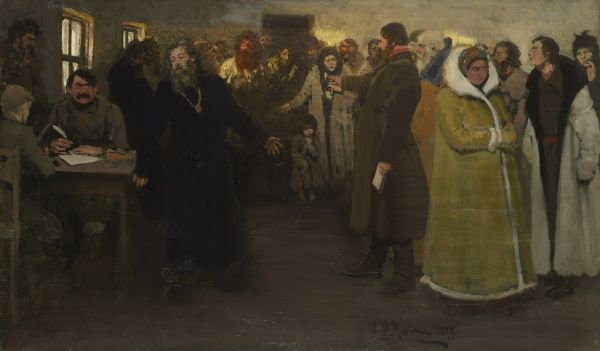|
|
In Volost Office. 1877

Repin Ilya,
Oil on сanvas
47,5 x 80
State Russian Museum
Пост. из собр. Н.Д. Ермакова
Annotation
The peak of Repin’s creative work occurred in the end of 1870-s – 1880-s and coincides with the development of democratic tendencies in the Russian painting art. During this period the artist created the majority of his best historical paintings, portrait, depictions of everyday life of common people and revolutionary struggles. In this painting the artist develops the philippic tendencies introduced by V.G. Perov by giving his characters a grotesque feeling and at the same time depicting their bright nature and the events of everyday life in his own individual manner. A volost clerk was an influential person in a Russian village, a link between common peasants and state authorities. Volost clerks collected and submitted information for reports, memos, summaries, and reformation projects. Volost clerks were paid a salary “from people’s charges”, and sometimes the sum of such payments reached the level of remuneration payable to noble statesmen. This shows the importance of a volost clerk’s position. Keen observation skills, active use of poses and gestures to give emotional characteristics, masterful creation of psychological atmosphere – all these typical features of I.E. Repin’s style can be observed in this painting.
Author's Biography
Repin Ilya
Repin, Ilya Yefimovich
1844, Chuguyev (Kharkiv Province) - 1930, Kuokkala (Finland)
Painter, draughtsman, watercolour painter, portraitist, history painter. Studied under local artists at the School of Military Topography in Chuguyev (1854-57), under Ivan Kramskoi at the School of Drawing, Society for the Encouragement of Artists (1863) and at the Imperial Academy of Arts (1864-71). Fellow of the Imperial Academy of Arts in Italy and France, lived mostly in Paris (1873-76). Academician (1876). Professor, full member of the Imperial Academy of Arts (1893). Member of the Society of Travelling Art Exhibitions (1878, exhibited from 1874). Headed a studio at the Higher School of Art, Imperial Academy of Arts (1894-1907) and taught at Princess Maria Tenisheva''s school of art (1895-98). Lived in St Petersburg and Moscow, settled in Kuokkala (1900).

